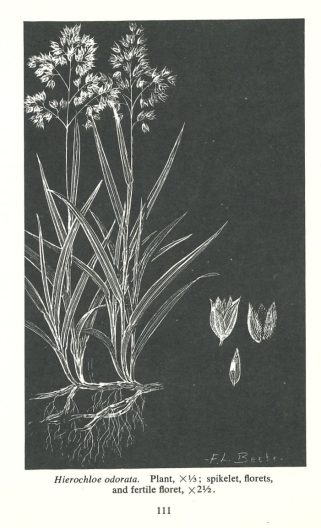My book club is reading Robin Kimmerer’s Braiding Sweetgrass. Do you know anywhere I could go to smell and see the plant? Might some be planted outside the Burke Museum, or at the Center for Urban Horticulture? What are local native uses of the plant?

In the context of Robin Wall Kimmerer’s book, sweetgrass probably refers to the plant whose scientific name is Hierochloe odorata. It grows in limited locations in Washington State. We do not have it here at the Center for Urban Horticulture. It is unlikely to have been planted around the Burke Museum, given its preference for marshy areas. Most of their plantings are at the edges of the parking lot. However, you could call and ask. You might be able to smell sweetgrass in woven items made from the plant, though the fragrance might not be as intense as the odor of the living plants.
The trouble with common names is that they may refer to different plants (not only a different species, but even a different genus and family), depending on what region of the world one inhabits. Kimmerer, who lives in Syracuse, New York, is a member of the Potawatomi tribe. The name she uses for sweetgrass is wiingashk ᐐᓐᑲᔥᒃ᙮, which is Ojibwe, a language that is linguistically similar to Potawatomi.
To give just one example of the potential for confusion, there is a Pacific Northwest ‘sweetgrass’ used by basket weavers on the Olympic Peninsula which is Schoenoplectus pungens, also called chairmaker’s clubrush or common three square, an entirely different genus in the sedge family (not in the grass family). The book does not mention its use for incense or fragrance, but the species name (pungens) does suggest it has an aroma, though possibly a sharp but not a sweet one. [source: From the Hands of a Weaver: Olympic Peninsula Basketry through Time, University of Oklahoma Press, 2012]
Examples of Hierochloe odorata’s use in the Pacific Northwest:
- The Okanagan-Colville tribe has a tradition of storing the braided blades among clothing, to lend a pleasant fragrance.
- The Haisla and Hanaksiala use blades in basketry.
- In the book Thompson Ethnobotany: Knowledge and Usage of Plants by the Indians of British Columbia (by Nancy J. Turner et al., 1990), the plant goes by several names in the tribal language, all of which refer to a good scent. Sweetgrass also goes by the name vanillagrass and the Thompson tribal tradition is to tie the grass in one’s hair, or wear it as a fragrant neck or arm ornament.
- The book Ancient Pathways, Ancestral Knowledge: Ethnobotany and Ecological Wisdom of Indigenous Peoples of Northwestern North America (Nancy J. Turner, 2014) mentions the use of sweetgrass braids (using Hierochloe) in ceremonial smudging for spiritual protection.